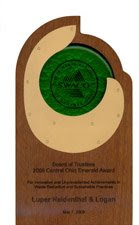By Amanda Bucha
A recent report from the Brookings Institution shows that the Columbus metro resident’s carbon footprint is above the national average. Columbus residents in the metro area emitted almost one more ton of carbon from the highway travel and home energy use than the average American metro resident.
In response to this trend, Mayor Coleman recently signed the U.S. Mayors Climate Protection Agreement, and the Central Ohio Green Pact. According to their website, the Green Pact includes some of the following guidelines:
· Growing a Strong, Green Economy - Collaborate to make sure that Central Ohio develops a larger market share of green businesses. Work together to attract and retain green businesses, and celebrate and reward existing businesses that adopt sustainable practices.
· Educating and Engaging Our Communities – Encourage greater environmental stewardship by residents and local businesses. Reach out to our stakeholders and citizens to teach the value and practice of sustainable living. Make periodic reports to our community about our efforts.
· Preserving Green Space and Creating Greenways - Support regional efforts to conserve streams, wetlands, forests and the other important natural resources of Central Ohio and increase the amount of parks and recreation areas for our residents. Create an interconnected system of greenways and bike trails that provide opportunities for alternative transportation, outdoor recreation, and healthy living.
· Mass Transportation - Explore ways to improve and promote alternative transportation in Central Ohio; including exploration of mass transit, promotion and exploration of incentives for our employees to take the bus, bike, or carpool to work.
Some examples of ways the city is changing include the development of the new Scioto Mile Audubon Metro Park and the recent renovations of the Lazarus Building. The former is described as an 80-acre green sanctuary on the Whittier Peninsula, which will expand green space in the city. According to the Whittier Peninsula Advisory Committee, the mission of this new park is to “provide a natural area park on the Whittier Peninsula. The focus of this partnership will be environmental education, passive outdoor recreation, and the expansion of a quiet natural space near downtown.” Their vision is to “transform the warehouses, impound lots, and old manufacturing sites back to woods, meadows, and wetlands.”
The Lazarus building has been getting national attention as one of the most eco-friendly development projects in the nation. Its rainwater filtering system and “green roof”, which consists of a wide variety of plants, allow the building to recycle rainwater which is then used to heat, ventilate, and cool the building. Rainwater is collected in the roof tank and piped into a tank in the basement of the building where it is recycled. Because the plants use the rainwater, they help prevent it from entering the sewer systems.
Learn more about the Scioto Mile Audubon Metro Park and the Lazarus Building by clicking the links!
Resources:
McIntyre, Melanie. “Columbus’ carbon footprint among highest in the nation”. The Daily Reporter (Columbus, Oh) 2 June 2008: 1.
The City of Columbus. 30 Oct. 2007. The City of Columbus. 10 June 2008 <http://getgreencolumbus.com/PDFs/GreenPact.pdf>.
Columbus Metro Parks Whittier Peninsula Advisory Committee – Park Program. 25 April 2006. Columbus Metro Parks. 10 June 2008.
Matt Burns. "Green Lazarus building gets national accolade.” Columbus Business First. (25 Sept. 2007) 10 June 2008.
<


No comments:
Post a Comment